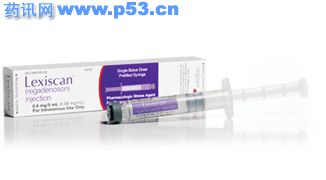|
制造商: Lexiscan is a pharmacologic stress agent indicated for radionuclide myocardial perfusion imaging (MPI) in patients unable to undergo adequate exercise stress. IMPORTANT SAFETY INFORMATION Do not administer Lexiscan to patients with second- or third-degree AV block or sinus node dysfunction unless these patients have a functioning artificial pacemaker. Fatal cardiac arrest, life-threatening ventricular arrhythmias, and myocardial infarction may result from the ischemia induced by pharmacologic stress agents. Cardiac resuscitation equipment and trained staff should be available before administering Lexiscan. Adenosine receptor agonists, including Lexiscan, can depress the SA and AV nodes and may cause first-, second-, or third-degree AV block, or sinus bradycardia requiring intervention. In postmarketing experience, heart block (including third degree), and asystole within minutes of Lexiscan administration have occurred. Adenosine receptor agonists, including Lexiscan, induce arterial vasodilation and hypotension. In postmarketing experience, syncope, transient ischemic attacks, and seizures have been observed. In clinical trials, decreased systolic blood pressure (>35 mm Hg) was observed in 7% of patients and decreased diastolic blood pressure (>25 mm Hg) was observed in 4% of patients within 45 minutes of Lexiscan administration. The risk of serious hypotension may be higher in patients with autonomic dysfunction, hypovolemia, left main coronary artery stenosis, stenotic valvular heart disease, pericarditis or pericardial effusions, or stenotic carotid artery disease with cerebrovascular insufficiency. Adenosine receptor agonists, including Lexiscan, may result in clinically significant increases in blood pressure in some patients. When it occurred in clinical trials, increased blood pressure was observed within minutes of Lexiscan administration, and in most cases, resolved within 10 to 15 minutes. In some cases, blood pressure increases were observed 45 minutes following Lexiscan administration. In postmarketing experience, cases of potentially clinically significant hypertension have been reported, particularly in patients with underlying hypertension and when low-level exercise was included in the MPI. Adenosine receptor agonists, including Lexiscan, may cause bronchoconstriction and respiratory compromise. For patients with known or suspected bronchoconstrictive disease, chronic obstructive pulmonary disease (COPD), or asthma, appropriate bronchodilator therapy and resuscitative measures should be available prior to Lexiscan administration. Lexiscan overdosage may result in serious reactions. Aminophylline was used as a reversal agent in 3% of patients. The most common adverse reactions (≥5%) to Lexiscan are dyspnea, headache, flushing, chest discomfort, angina pectoris or ST-segment depression, dizziness, chest pain, nausea, abdominal discomfort, dysgeusia, and feeling hot. Most adverse reactions began soon after dosing, and generally resolved within approximately 15 minutes, except for headache, which resolved in most patients within 30 minutes. In postmarketing experience, abdominal pain in association with nausea, vomiting, or myalgias, and diarrhea, fecal incontinence, musculoskeletal pain, and tremor have occurred. Intravenous Adenoscan is indicated as an adjunct to thallium-201 myocardial perfusion scintigraphy in patients unable to exercise adequately. IMPORTANT SAFETY INFORMATION Adenoscan is contraindicated in patients with second- or third-degree AV block, unless these patients have a functioning artificial pacemaker, sinus node disease, and known or suspected bronchoconstrictive or bronchospastic lung disease. Fatal cardiac arrest, sustained ventricular tachycardia (requiring resuscitation), and nonfatal myocardial infarction have been reported coincident with Adenoscan infusion. Patients with unstable angina may be at greater risk. Appropriate resuscitative measures should be available. Adenoscan is a potent peripheral vasodilator and can cause significant hypotension. The risk of hypotension may be higher in patients with cardiac or cerebrovascular insufficiency. Adenoscan exerts a direct depressant effect on the SA and AV nodes and has the potential to cause first-, second- or third-degree AV block, or sinus bradycardia. Increases in systolic and diastolic pressure have been observed. Adenosine receptor agonists, including Adenoscan, may cause bronchoconstriction and respiratory compromise. Atrial fibrillation has been reported in patients with Adenoscan infusion and may last from a few seconds to hours, however, patients spontaneously converted to normal sinus rhythm. Most common adverse reactions (≥5%) to Adenoscan are flushing, chest discomfort, dyspnea, headache, discomfort of the throat, neck, or jaw, gastrointestinal discomfort, and lightheadedness/dizziness. Side effects with Adenoscan usually resolve quickly when the infusion is discontinued, although delayed or persistent effects have been observed. |
Lexiscan (regadenoson)注射剂简介:
制造商: 安斯泰来制药美国公司 药理分类: 应激剂(甘酸A2A腺苷受体激动剂) 活性成分(补): Regadenoson 0.4mg/5mL;溶液为四损伤;不含防腐剂。 指示(补): 放射性核素心肌灌注显像患者无法(MPI) ... 责任编辑:admin
|
最新文章更多推荐文章更多热点文章更多
|


